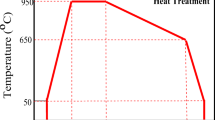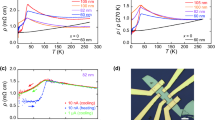Abstract
TDPAC study of InBi1−x Te x with x=0.0, 0.01, 0.05, 0.1 and 0.2 as a function of temperature is done. Both pure and Te-doped samples show a semi-metallic character up to around room temperature. Above room temperature a steep transition to semiconducting state was observed, which is independent of the doping concentrations. Hence Te may be in the interstitial sites. Conductivity measurement of the above samples showed the same trend as observed in the EFG studies. Thus the importance of the conduction electron density is prominently seen in these systems.
Similar content being viewed by others
References
Kaufmann, E. N. and Vianden, R. J., Rev. Mod. Phys. 51 (1979), 161.
Witthuhn, W., Hyp. Interact. 24-26 (1985), 547.
Hasimoto, K., J. Phys. Soc. Japan 12 (1957), 1423.
Lis S. A. and Naumann, R. A., J. Phys. 6(12) (1976), 2307.
Pal, G., Ph.D. Thesis, M.S. University of Baroda, India, 1999 (unpublished).
Author information
Authors and Affiliations
Rights and permissions
About this article
Cite this article
Pal, G., Sebastian, K.C. & Somayajulu, D.R.S. EFG Studies at 111Cd in InBi Systems. Hyperfine Interactions 136, 613–617 (2001). https://doi.org/10.1023/A:1020530623249
Issue Date:
DOI: https://doi.org/10.1023/A:1020530623249




